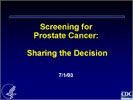

|
 |

Prostate Cancer > Spotlight on Screening
Spotlight on Prostate Cancer Screening

Informed Decision Making: How to Make a Personal Health Care Choice
On this page
The Public Health Problem
In 2004, approximately 230,110 new cases of prostate cancer will be diagnosed and
29,900 men will die of the disease.1 Currently, there is no scientific consensus on
effective strategies to reduce the risk of prostate cancer. Additionally, there is no
agreement on the effectiveness of screening or that the potential benefits outweigh
the harms. Therefore, public health agencies face
significant challenges in determining what actions to take to address prostate cancer.
Given the uncertainty about the benefit of screening, the principle public health
approach is to support informed decision making about screening. Public health agencies
and related organizations are attempting to provide men with current information about
the benefits and risks of prostate cancer screening so that each man can make his own
decision, given his own values and preferences.
1Source: Cancer Facts and Figures 2004, American
Cancer Society, 2004.
Top of Page
CDC’s Response
 |
 |
 |
 |
 |
Shared decision making
is a process carried out between a patient and
his health care professional in the clinical setting where both
parties share information and the patient understands the nature
and risks of prostate cancer; the risks, benefits and alternatives to
screening; participates in decision making at a level he desires; and makes a
decision consistent with his preferences and values, or defers the decision to a
later time. more...
|
 |
 |
 |
 |

 |
 |
 |
 |
Informed decision making occurs when an individual understands
the nature and risks of prostate cancer; the risks, benefits, and
alternatives to screening; participates in decision making at a level he desires;
and makes a decision consistent with his preferences and values, or defers the decision
to a later time. more...
|
 |
 |
 |
 |
|
CDC has developed a portfolio of educational materials about prostate cancer screening,
which are designed to promote discussion between patients and physicians and to help men aged
50 years or older make informed decisions about prostate cancer screening.
These materials include
Screening for Prostate Cancer: Sharing the Decision
 A slide presentation developed to provide primary care providers
(i.e., physicians, nurse practitioners and physician assistants) with current information
on prostate cancer screening and to encourage the use of shared decision–making.
Also included is a Toolkit and
a Bibliography for the slide
presentation.
A slide presentation developed to provide primary care providers
(i.e., physicians, nurse practitioners and physician assistants) with current information
on prostate cancer screening and to encourage the use of shared decision–making.
Also included is a Toolkit and
a Bibliography for the slide
presentation. |
Prostate Cancer Screening: A Decision Guide
 An easy-to-read booklet,
organized in question and answer format, designed to help a man decide whether screening
is right for him. The guide discusses the prostate, prostate cancer and the available
screening tests.
An easy-to-read booklet,
organized in question and answer format, designed to help a man decide whether screening
is right for him. The guide discusses the prostate, prostate cancer and the available
screening tests.
The newest edition to CDC’s educational family of products is an informed decision-making
guide that targets African American men. At all ages, African-American men die of prostate
cancer more often than do other men. The reasons for the variation among groups are unknown,
making it critical that African American men know the facts about prostate cancer and the
available screening tests.
Prostate Cancer Screening: A Decision Guide for African Americans
 A booklet organized in an easy-to-read question and answer format that discusses the
prostate gland, prostate cancer, and the screening tests for the disease.
This guide is designed specifically for African American men, provides basic information
and encourages men to decide whether screening is the right choice for them.
A booklet organized in an easy-to-read question and answer format that discusses the
prostate gland, prostate cancer, and the screening tests for the disease.
This guide is designed specifically for African American men, provides basic information
and encourages men to decide whether screening is the right choice for them.
Top of Page
Spotlight on Science
Prostate-specific antigen test use reported in the 2000 National Health Interview Survey
In 2000, the National Health Interview Survey (NHIS) collected information about
prostate-specific antigen (PSA) test use in a representative sample of U.S. men.
This study examined PSA test use in subgroups of men, defined by personal and social
characteristics. Among men aged 50 years and older with no history of prostate cancer,
56.8% reported ever having had a PSA test, 34.1% reported having had a PSA test during
the previous year, and 30% reported having had three or more tests during the previous
5 years. Screening was greater among men aged 60 – 70 years, those with greater access to
care, and those practicing other preventive behaviors Among men in their 40s, use tended
to be higher among African-American men. The prevalence and patterns of PSA screening
suggest that it is used like other cancer screening tests among about a third of
U.S. men. Because of the lack of scientific consensus on whether prostate cancer
screening is beneficial, more information is needed on how knowledgeable both patients
and practitioners are about the potential benefits and harms of screening and how
prostate cancer screening decisions are made.
Ross LE, Coates RC, Breen N, Uhler RJ, Potosky AL, and Blackman D.
Prostate-specific antigen test use reported in the 2000 National Health
Interview Survey. Preventive Medicine 2004;38(6):732–744.
Top of Page
|
 |




 A slide presentation developed to provide primary care providers
(i.e., physicians, nurse practitioners and physician assistants) with current information
on prostate cancer screening and to encourage the use of shared decision–making.
Also included is a
A slide presentation developed to provide primary care providers
(i.e., physicians, nurse practitioners and physician assistants) with current information
on prostate cancer screening and to encourage the use of shared decision–making.
Also included is a